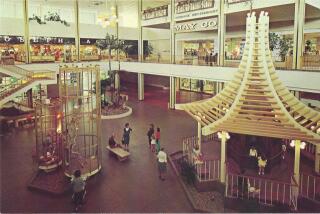Thousand Oaks Officials Drop Plan to Reveal Income Data for Stores : Businesses: Merchants’ concerns persuade a panel not to post confidential figures for boulevard firms at a plaza workshop.
- Share via
Armed with signatures from 66 business owners along Thousand Oaks Boulevard, merchant Tina Carlson went to the City Council meeting Tuesday night to protest a city plan to redesign the community’s main thoroughfare.
The plans to enhance the city’s sprawling center--making it more pedestrian- and consumer-friendly as well as more attractive--have been skeptically received by some merchants throughout two years of discussion.
But last week those concerns escalated when Carlson and other merchants learned that confidential income information about their stores was to be made public during a daylong community workshop at the Civic Arts Plaza on Sunday.
“Collecting and disseminating such information is a breach of trust by the city,” Carlson told council members Tuesday. “Why does the community need to know how much these businesses make?”
During a Mayor’s Business Roundtable meeting, business owners were told a map would be posted at the workshop that would include a store-by-store breakdown of sales tax revenue.
That didn’t seem right to many of them. For one thing, competitors could easily determine a store’s income from extrapolating sales tax.
Anyone wanting to rob a store could also easily figure out how much might be in the till on any given day. And finally there is simply the issue of privacy.
“Would you like someone to know how much might be in your bank bag when you leave work every night?” Carlson asked the council members.
The Carlson family consulted an attorney and found that the tax information is private. If the redesign committee went ahead with plans to include the tax data, it would be breaking the law, the attorney said.
Outraged, they sent a letter Monday to the city attorney demanding that the map be shelved. Redesign committee members now say it will not be used and that they simply had no idea the information was protected by law.
“It could have been a major mistake,” acknowledges architect Francisco Behr, an active member of the committee. “But it was caught in time.”
“There is nothing that will be available to anybody in the public regarding economic information for any of the businesses on Thousand Oaks Boulevard,” Behr added. “I believe the map that was started was destroyed.”
But for Behr and others on the committee, the issue of the tax data brings up a lingering problem--the reluctance of many boulevard business owners to see change on the street.
“I don’t know anyone who is happy with it (the redesign plan),” said Marilyn Murdoch, who has owned a trophy shop on the boulevard for 11 years. “We look at it and say, ‘It’s not broken.’ But they want to change things.”
A proposal to have trolley service up and down the street draws a hoot of derision from Murdoch. The kind of businesses on the boulevard aren’t oriented to trolley shopping, she said.
“That is a joke,” she said. “People don’t have time for that. You aren’t going to take your dry cleaning on a trolley.”
Russ Goodenough, a boulevard business owner and member of the redesign committee, said he understands why Carlson and others would question the plans.
“In the past we as a business community have had a lot of things forced down our throats by the government,” he said. “A lot of business owners are concerned because of the crap that has gone on in the past.
“When I saw that map I was kind of offended myself,” Goodenough added.
“That’s proprietary information that has no place in the public domain.”
But at the same time, Goodenough wholeheartedly supports efforts to redesign the city’s oldest street, believing some areas of the busy street could be made better-looking by adding sidewalks, fountains and planters.
“We don’t want to fall into the same problems that we see in a lot of the boulevards in the San Fernando Valley,” he said. “We are trying to avoid the appearance of decay.”
More to Read
Inside the business of entertainment
The Wide Shot brings you news, analysis and insights on everything from streaming wars to production — and what it all means for the future.
You may occasionally receive promotional content from the Los Angeles Times.










